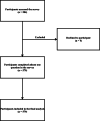Assessment of COVID-19 Information Overload Among the General Public
- PMID: 33469869
- PMCID: PMC7815186
- DOI: 10.1007/s40615-020-00942-0
Assessment of COVID-19 Information Overload Among the General Public
Abstract
Background: A relentless flood of information accompanied the novel coronavirus 2019 (COVID-19) pandemic. False news, conspiracy theories, and magical cures were shared with the general public at an alarming rate, which may lead to increased anxiety and stress levels and associated debilitating consequences.
Objectives: To measure the level of COVID-19 information overload (COVIO) and assess the association between COVIO and sociodemographic characteristics among the general public.
Methods: A cross-sectional online survey was conducted between April and May 2020 using a modified Cancer Information Overload scale. The survey was developed and posted on four social media platforms. The data were only collected from those who consented to participate. COVIO score was classified into high vs. low using the asymmetrical distribution as a guide and conducted a binary logistic regression to examine the factors associated with COVIO.
Results: A total number of 584 respondents participated in this study. The mean COVIO score of the respondents was 19.4 (± 4.0). Sources and frequency of receiving COVID-19 information were found to be significant predictors of COVIO. Participants who received information via the broadcast media were more likely to have high COVIO than those who received information via the social media (adjusted odds ratio ([aOR],14.599; 95% confidence interval [CI], 1.608-132.559; p = 0.017). Also, participants who received COVID-19 information every minute (aOR, 3.892; 95% CI, 1.124-13.480; p = 0.032) were more likely to have high COVIO than those who received information every week.
Conclusion: The source of information and the frequency of receiving COVID-19 information were significantly associated with COVIO. The COVID-19 information is often conflicting, leading to confusion and overload of information in the general population. This can have unfavorable effects on the measures taken to control the transmission and management of COVID-19 infection.
Keywords: COVID-19; General public; Information overload.
© 2021. W. Montague Cobb-NMA Health Institute.
Conflict of interest statement
The authors declare that they have no competing interests.
Figures
References
-
- Bawden D. Robinson L. Information overload: an overview. Oxford Encyclopedia of Political Decision Making. Oxford University Press; 2020.
-
- Eppler MJ, Mengis J. A framework for information overload research in organizations. Università della Svizzera italiana. 2003.
-
- Wang C, Pan R, Wan X, Tan Y, Xu L, Ho CS, Ho RC. Immediate psychological responses and associated factors during the initial stage of the 2019 coronavirus disease (COVID-19) epidemic among the general population in China. Int J Environ Res Public Health. 2020;17(5):1729. doi: 10.3390/ijerph17051729. - DOI - PMC - PubMed
MeSH terms
LinkOut - more resources
Full Text Sources
Other Literature Sources
Medical
Miscellaneous



